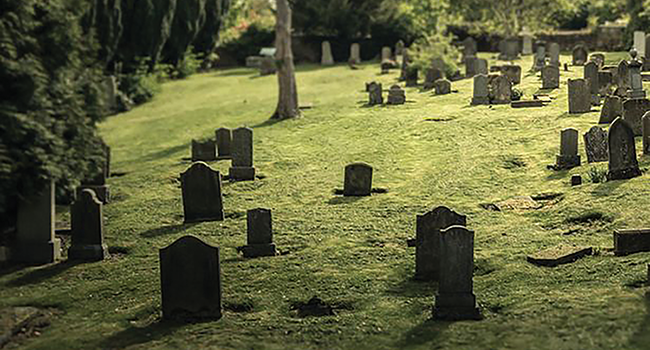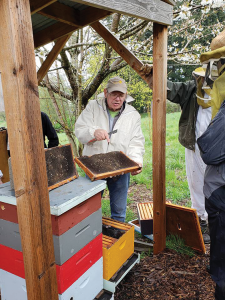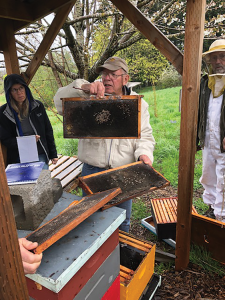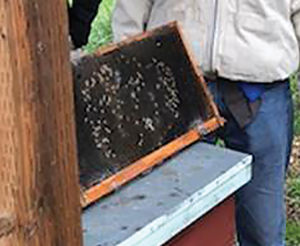By: Dewey Caron
Bees die overwinter for a number of reasons.
Of course, seasonal losses occur as well, and they too might have a number of root causes. By performing a dead colony necropsy we might be able to determine the likely reason for non-survivorship. Although dead colony examinations are often not clear cut, understanding the why might help us avoid a repeat the next time
This Spring I joined about a dozen brave individuals gathered in a Portland, OR club apiary mid-April, during a steady Oregon “liquid sunshine” rain event, to do a dead colony examination workshop. Temperature was low 50s, with only a couple foraging bees venturing forth from four of eight colonies. We did necropsy on two deadouts.
Fall deadout
The first deadout, a colony that died in the Fall before overwintering, proved to be a tough diagnosis (photo 1 shows deadout).
The colony was a mid-May nuc start, a donation to the Portland Urban Beekeepers (PUB) association. During the season the hive, although started late, grew from nuc-size and in the Fall consisted of a standard and a shallow. The shallow frames were quite full (>3/4ths of cells) with capped honey with no evidence of robbing. There were dead brood remains on three frames of the lower standard box, plus a small number (<3000 individuals) of dead adult bees on the screen bottom board and immediately outside the entrance.
The brood frames did not have the appearance of a normal colony. Two adjacent frames had widely scattered capped brood cells extending in an oval over 1/2 of the middle of the frames; there was a fist-sized patch of compact capped brood but it was not contiguous with the scattered brood of the other two frames. There were no remains, or evidence, of winter cluster formation.
There were a considerable number of cells of stored pollen on five frames. Ample fungus and mold was evident in pollen cells and as a powdery, grayish mold on surface of cells. No wax moth activity was evident. Colony was sampled for mites with a sugar roll in September and had only two mites (<1%). It was NOT treated for mites as it was a non-treatment control. Colony was alive but noted as weak in a mid-October inspection the previous Fall. Individual colony records are kept of each colony in this apiary; they can prove handy in an necropsy.
Photo of the three frames with brood shows the frame with a patch of compact brood (held in my right hand) and two frames with very scattered brood (one in my left hand and the third on top of adjacent hive – see Photo 2). One frame with widely scattered capped brood remains is shown isolated in photo 3.
So what can we diagnose? The dead colony had lots of honey and bee bread stores so we can likely rule out starvation. Small number of dead bee bodies suggests a small colony but if we would believe death resulted from a too-small population of adults, there should have been evidence of a cluster with bees head first within cells and dead bee remains on the frame(s). There wasn’t.
Thus our best guess for reason for colony death is a colony that had a BEE PMS condition. The scattered brood remains on both sides of two frames suggests PMS – a spotty (snot) brood situation MIGHT have been diagnosed in the October examination, but this requires a close examination of the brood; we might also have noticed evidence of too few adult bees to cover the brood – both are subtle clues of PMS in a Fall colony.
The fist-sized brood area, one frame over from the other two frames with scattered brood, might have been bees trying to escape the high mite numbers and dying, unhealthy brood of the two frames with scattered cells. Adult bees were likely dying prematurely from their mite and/or virus infestation and abandoning their (unhealthy) hive, thus the reason we saw only a smallish number of dead adult bees. The colony likely failed to rear sufficient fat, Fall bees.
The colony probably died within a month after the last October inspection, probably from a virus epidemic related to the mite infestation. NOTE: The September mite sample is misleading/confusing (we would expect it to have been higher); if an additional sample was taken it would perhaps have been higher? We might surmise that one or more colonies in the area had high mite numbers (see description of 2nd deadout below) and thus colony mite numbers could have increased rapidly in the Fall.
The apiary had heavy yellow jacket predation, something beekeepers cite as “cause” for colony loss. These scavengers however find and exploit weaker colonies and are likely more a secondary factor in colony demise.
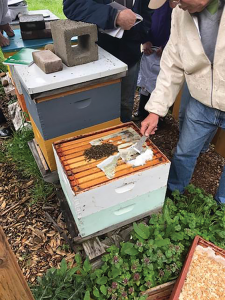
Spring deadout autopsy. Show is adult bees in tight cluster, extending over three frames. At back corner (below hive tool) is dry sugar that was not utilized. (photo by Deb Caron)
Spring deadout
The second deadout was a more standard necropsy. Hive was a spring split from a strong overwintered colony in which a mated queen was added. Colony struggled all season; again a demonstration of the value of keeping good hive records. In the fall, colony consisted of two shallows. Colony had a 19 mite count (6%+) in early September after which it was treated with two formic pads between the two boxes. It was alive in mid-March (Spring 2018) but again noted as small with little food (i.e. capped honey or cells of pollen). It was fed dry sugar directly on the top bars on paper (some sugar was still remaining in mid-April – see photo 4) and provided with a frame of hard sugar candy, immediately adjacent to the brood.
Opening the top and removing the moisture trap, (many Oregon hives and all hives in this apiary had Vivaldi moisture trap/quilt board at top) showed a dead cluster of adult bees on three frames at top of the top box extending down about ½ way on the three frames (see photo 4; hive tool is showing the remaining dry sugar on paper – quilt board moisture trap with wood shaving on ground in lower right of photo). The adult bees were wet, black and showed excessive moisture; there were many maggots (scavenger fly) feeding on the dead bees. The dead queen was found among the dead bodies. See Photo 5 for closer view of one of the three frames with dead cluster.
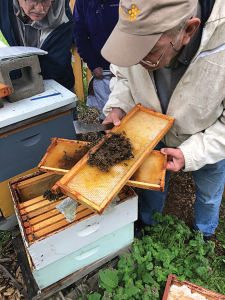
Close up of frame with dead bee cluster mid-April. This colony survived the Winter but most likely starved when they could not use the dry sugar or hard candy emergency feed. Capped brood (lower margin) is evident, cells above capped brood were filled with adult bees, head in. There are no cells of honey nor pollen. Fly maggots were extensive among the wetted dead adult bees.
There was capped brood in compact pattern at margin of the cluster on all three frames. The cells in center of the clustered bees all contained bees, head first (butts out) in the cells. The dead adult population was small (perhaps 8-10,000 bees). There was NO capped honey in any of the frames of either box. Lower box was empty. There were some dead bees on solid bottom board. There was little mold.
So what was diagnosis of this 2nd deadout examination? The dead cluster is characteristic of a colony that overwintered the tough, cold, wet Winter months (December-February). Moisture of adult bees, maggots and little mold suggests recent death, confirmed via the mid-March hive journal entry. The compact brood shows the colony was starting to expand in the Spring (flight was noted in March). Although dry sugar (as candy and crystal sugar) was given as emergency feed (hefting would have revealed lack of enough stores), it turned out to not be enough – colony likely starved.
The dry feed (dry crystallized and hard sugar candy) confuses this diagnosis. I believe there might have been too small a cluster to generate enough heat to make slurry out of the dry sugar/hard candy, so bees couldn’t use it. Photo 5 shows close up of one of the three frames with the dead clustered bees, “bee butts” in cells under the dead cluster and compact capped brood.
Season colony loss autopsies
When colonies have a queen replacement event they can end up queenless for a variety of reasons. Queen replacement is risky behavior. We will see this as a dwindling colony, perhaps even as laying worker condition. For a short while we can confirm queen event by seeing the cut back remains of queen cells. But colonies can be weak for any number of reasons, witness the struggles the Spring deadout had during the season. Feeding syrup, protein and later uniting the weak colony to a stronger one might have improved the chances of it surviving (take Winter losses in the Fall).
Colonies may swarm late in the Spring/early Summer or abscond and we might find a dead (or weakened) colony in early Fall as we begin to assist colonies with Winter preparations. Absconding is the behavior of bees (and queen) leaving their hive during the Summer due to several possible number of reasons. High mite numbers and BEE PMS are two likely reasons for September and October “swarms” – in reality an unsuccessful attempt by sick, stressed colonies to find an alternative home.
Disease may weaken colonies but, with the exception of viruses, are unlikely to kill a colony. Unless dequeened (for example chalkbrood, EFB) the disease may reappear in the Spring and result in slower colony development and Spring expansion. American foulbrood may eventually result in a dead colony but it often takes more than a single season. AFB, like mites, can be treated when discovered but sometimes we do not get proper diagnosis until it is too late to effectively rescue the colony; unfortunately such colonies become targets for robbing and the disease/mites spread to otherwise healthy colonies.
Pesticides remain a factor in dead colonies. At one time acute pesticide kills could be diagnosed by finding large numbers of dead foragers immediately outside (sometimes inside) the colony and dying neglected brood from lack of adult care. Determining if a pesticide might be a factor in a dead/weakened colony is more difficult today. Newer pesticides are more likely to affect adult behavior, shorten adult life and cause loss of one or more brood generations. Damage may not be acute but rather expressed as chronic damage, negatively impacting a colony long term. Placement of colonies near certain crops will risk the possibility of pesticide losses or weakening of colonies.
In late Summer/Fall we increasingly hear of colonies similar to Deadout #1 described above. Colonies that are apparently healthy and developing normally during the season quickly go downhill. In the Fall they fail to rear sufficient healthy bees to overwinter. The number of mites, but more likely, the presence of certain viruses in the apiary, such as Deformed wing virus (DWV), Varroa destructor Viruses (VDV-1) and one or more of the paralysis viruses (CBPV, ABPV, Kashmir Bee Virus (KBV) result in an epidemic. As in human flu viruses, bee viruses results in rapid loss of a colony. Analysis of viruses is expensive and not widely available so we are left to attempt to control the vector, the Varroa mite, as our best control option.
Failure to adequately control mites remains our number one factor in Fall and overwintering bee losses, in my opinion. It is a tough condition to adequately diagnosis, as shown in first deadout necropsy described here. But we should seek to make such a determination – it won’t help the dead colony but it could help us help our bees in a subsequent season to a better survival rate.
Postscript
The equipment from both Fall and Spring deadouts are likely OK to reuse. All frames, except one with high number of drone cells, could be reused for a new colony installation (package/swarm/ split). Brush off dead cluster from the three frames of the Spring deadout. There is no easy way to remove the dead bees within the cells and from bottom board. If inclined, wash mold with bleach or vinegar solution. When using the equipment for a new colony, initially use only some of the deadout frames, adding the remainder as the colony gets stronger.






